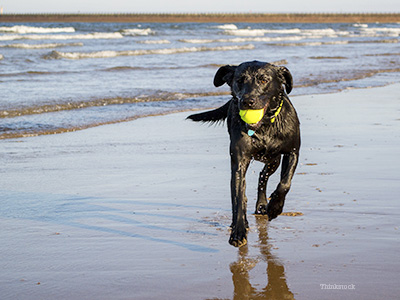I live near the beach and it is a significant part of my every day life. The ocean is a draw for people not just for fun but for meditation and rejuvenation too. Increasingly, dog owners take their dogs to the beach for exercise and companionship. It combines two of life’s great experiences -- a walk on the beach or along the water while spending time with a friend or loved one. In fact, it is not uncommon to see dogs come to the beach alone so I guess they are drawn to the ocean as well.
I love strolling on the beaches of pristine sand and blue water. I see dogs frolicking along the waterline so I assume they are enjoying themselves as much as we are. Naturally we walk barefoot through the water as it breaks on the sand. That is where the problem sometimes begins. You see dogs can be pretty nonchalant when it comes to their toilet habits. Much of the time they simply answer the call wherever they are. Now they may be well house trained and their owners may walk with them on a sidewalk, diligently picking up their droppings and disposing of them, but for some reason at the beach or lake all bets are off.

Protect the shores
Responsible dog ownership is not just for the home. There are certain courtesies that need to be adhered to wherever dogs and people share the environment. Nobody likes to step in a pile of dropping, especially if they are barefoot. Nobody likes to lie down in the sand and smell feces from a dog either.
To maker matters worse, many dogs are parasitized and in some areas hookworms are common. So there is a very real potential for public areas to be contaminated with hookworm eggs and larvae. There is a definite potential for these larvae to enter humans, particularly in the case of children and sunbathers, directly through the skin (Cutaneous larval migrans). Cutaneous larva migrans (CLM) is the most common tropically acquired dermatosis in man. It is the result of intestinal parasites primarily of dogs and cats entering through the skin of a new host1.
This can be avoided in several ways:
- First, de-worm all dogs regularly and use a monthly combination of heartworm and internal parasite control all year round.
- Second, enforce ordinances that prohibit dogs on the beach.
- Third, pick up your dogs stools and dispose of them just as you would at home. All of these steps are simple, responsible courtesies.
Protect your dog at the beach
It’s common for dog owners to encourage their dogs to play in the water -- chasing a ball into the surf, jumping into the lake or stream to chase a duck. It’s great fun until something goes wrong. Even a seemingly quiet stream can suddenly open into an area with a strong current that can sweep a dog downstream. Beaches, especially those that are unpatrolled, represent a very real risk of rip tides and breakers that can sweep a dog away into dangerous waters.
Frequently, owners who try and rescue their dog may become trapped in those same breakers and currents. Every year people trying to rescue dogs find themselves in danger and drowning is common.
Big waves can wash people into the water before they realize the threat. The solution is simple. Take precautions when around water and as I have been told repeatedly, “Never turn your back on the sea.”
So enjoy the shore. Have fun at the lake or on the river but always remember that you are responsible for the safety of your dogs and for being a good and responsible dog owner.
If you have any questions or concerns, you should always visit or call your veterinarian -- they are your best resource to ensure the health and well-being of your pets.
1. "Cutaneous Larva Migrans." Medscape.com. Ed. Lydia A. Juzych, MD. 31 July 2014. Web.
